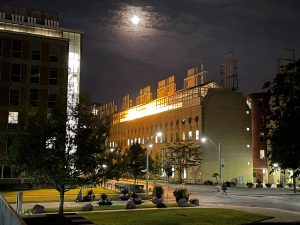 Settled on top of UofT’s Earth Sciences Centre on Huron Street are fifteen greenhouse zones for CSB and EEB researchers. High energy sodium lamps provide light to grow cultivated plants, but a new sustainability project is underway to replace these lamps with energy efficient LEDs.
Settled on top of UofT’s Earth Sciences Centre on Huron Street are fifteen greenhouse zones for CSB and EEB researchers. High energy sodium lamps provide light to grow cultivated plants, but a new sustainability project is underway to replace these lamps with energy efficient LEDs.
The Earth Sciences greenhouses contain specimens of hundreds of plants in specialized environments to mimic desert, tropical and temperate zones. These samples are used to understand cell biology, ecology and evolution in plants and often require high intensity light to flourish. When Earth Sciences was built in 1989, yellow sodium lamps provided the needed intensity, but these old lamps have poor energy efficiency.
A pilot project by Chief Horticulturalist Bill Cole to replace sodium lamps with LED panels has produced excellent results in one greenhouse. Cole says that “They look great and produce a high intensity balanced spectrum light. Ten 600W LED fixtures produce more light and are more energy efficient than fifteen 465W sodium vapour lights.”
 Direct energy savings are accompanied by additional benefits. The colour balance for the full spectrum LED lights is better for the plants, providing more red and blue wavelengths. The new lights produce less radiant heat which will also reduce the burden of cooling for the greenhouses. Cole has recommended proceeding with full replacement in all fifteen greenhouses planted on top of the Earth Sciences Centre.
Direct energy savings are accompanied by additional benefits. The colour balance for the full spectrum LED lights is better for the plants, providing more red and blue wavelengths. The new lights produce less radiant heat which will also reduce the burden of cooling for the greenhouses. Cole has recommended proceeding with full replacement in all fifteen greenhouses planted on top of the Earth Sciences Centre.
Funding for this project came from greenhouse operating funds, with support from CSB and EEB to arrange installation. A similar project in labs and offices of the nearby Ramsay Wright Building reduced energy consumption by 380,000 kilowatt hours annually. As the yellow glow above Earth Sciences transitions to a more even hue, UofT can count on even greater savings.
